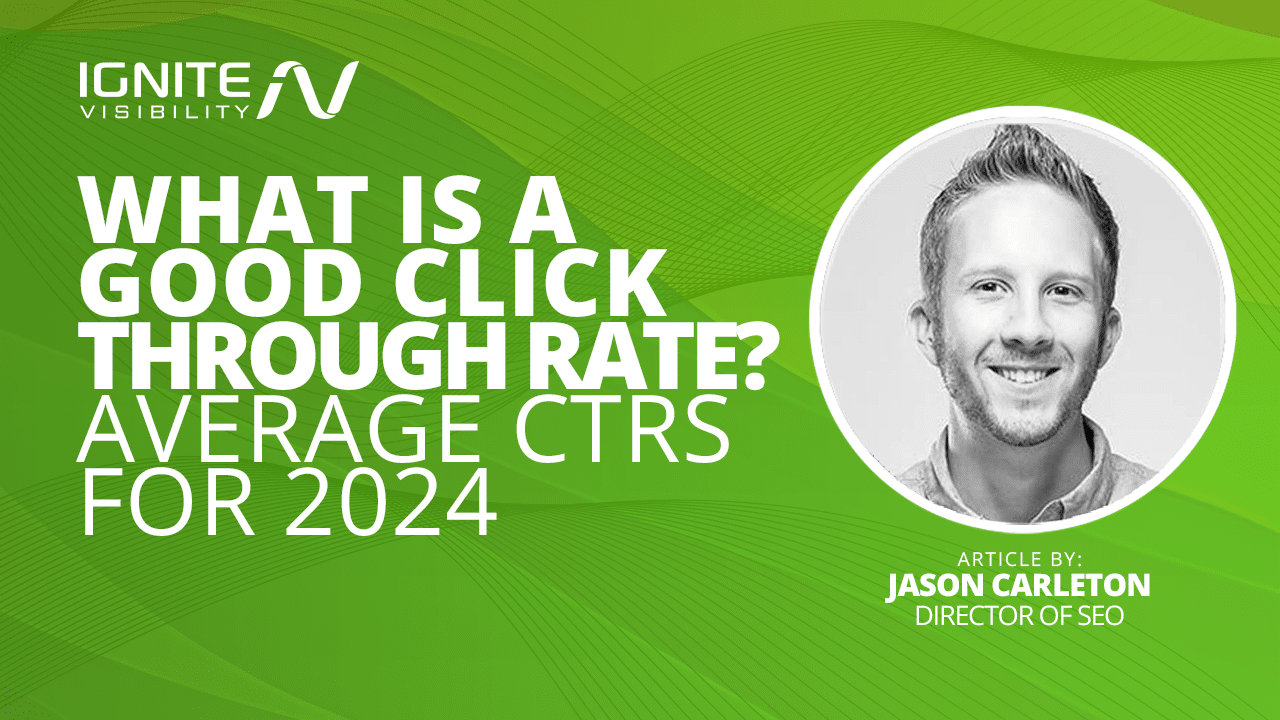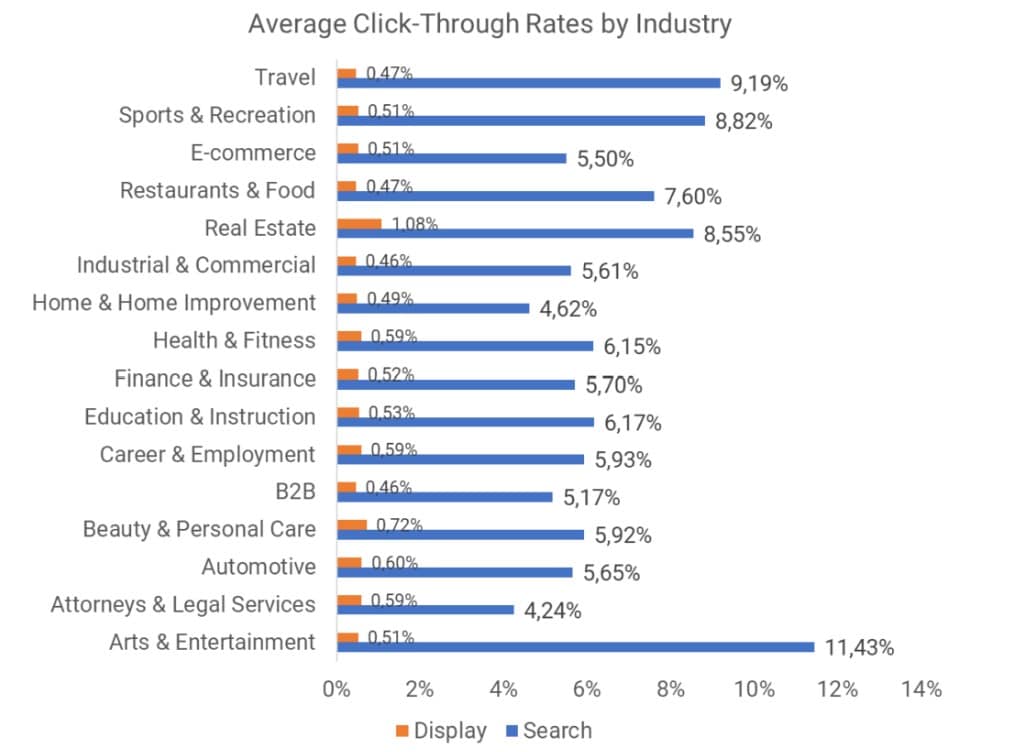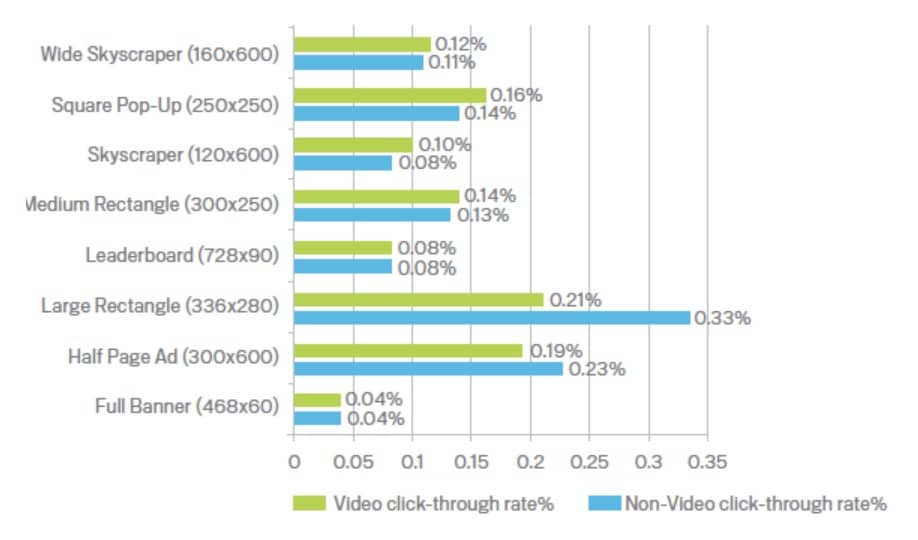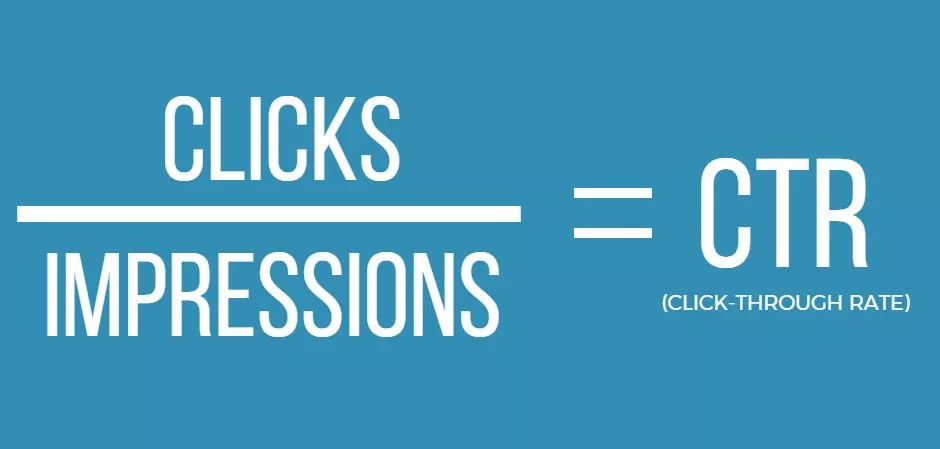
How would you know? Especially if you’ve never asked the question, “What is a good click-through rate?”
In this blog, Jason Carleton, Director of SEO, dives into all things CTR, including benchmarks and how to boost yours on social media.
What We’ll Cover:
- What is a Good CTR and How to Measure it
- What Influences CTR?
- Strategy for SEO
- Strategy for PPC
- Strategy for Display Ads
- Strategy for Email
- Strategy for Social Media
- FAQs
My Expert Insight on Click-Through Rates
We all know creating great content is crucial, but what if no one clicks on it?
That’s where CTR comes in. It’s your content’s welcome wagon, the first impression that entices viewers to take a deeper dive. A strong CTR indicates your headlines, meta descriptions, and visuals are captivating.
Conversely, a low CTR suggests tweaks are needed.
I recommend conducting regular CTR audits to identify underperforming content. A/B test different headlines and snippets to see what resonates best. Remember, strong CTRs translate to more website visitors, resulting in higher engagement rates and potentially, more conversions.
What is a Good Click-Through Rate?
When it comes to what is a good CTR, we need to first establish what a CTR is.
This number refers to the ratio of how many users click a specific link to the total number of users who view it.
The ratio would look something like this: User Clicks:Total Views
It measures how well your link – whether it’s a Google ad or Facebook copy – attracts people to your website.
The formula is Total Clicks/Total Impressions.
When Should You Calculate Your CTR?
There’s no need to become a CTR-checking machine, but there are some key moments to pay attention to.
- Launching New Content: Just like a delicious new dish at a restaurant, you want to see how your audience reacts to your fresh content. Checking your CTR helps you identify what’s working and where you can improve to make it even more irresistible.
- Running Ad Campaigns: CTR is your secret weapon when it comes to ad campaigns. Regularly monitoring your CTR allows you to optimize elements like headlines and visuals for better performance, maximizing the impact of your ad spend.
- Revamping Old Content: Sometimes even the best content needs a refresh. Checking the CTR of older pieces can help you understand what resonated with your audience before. Use that knowledge to breathe new life into the content and make it shine again.
Factors Influencing Your CTR
So, what makes a link click-worthy? Here are some key ingredients for a high CTR:
- Captivating Headlines and Descriptions: These are your digital billboards, so make them count! Craft clear, concise headlines that are rich in relevant keywords. Tease the reader with a benefit or a question to pique their curiosity. For descriptions, keep it short and sweet, but highlight what the content offers and why it matters.
- Eye-Catching Images and Videos: Visuals are powerful. High-quality, relevant images and videos can significantly boost your CTR. Think about what would grab your attention when scrolling through a feed. Would it be a stunning landscape photo for a travel blog or a quick explainer video for a tech tutorial?
- Strong Calls to Action: Don’t leave your audience guessing! Tell them what you want them to do next with a clear and compelling call to action. Whether it’s “Learn More,” “Shop Now,” or “Download the Free Guide,” make your calls to action stand out and encourage those clicks.
- Urgency and Scarcity: A little FOMO (fear of missing out) can be a powerful motivator. If your content offers a limited-time deal or exclusive information, highlight it! This creates a sense of urgency and encourages viewers to click before it’s too late.
- Credibility and Trust: People are more likely to click on links they trust. Build credibility by showcasing your expertise, positive reviews, or affiliations with reputable organizations.
Benefits of Keeping Your CTR High
A healthy CTR isn’t just about vanity metrics. Here’s why it matters:
- Boosts Search Ranking and Ad Quality Score: Google loves relevant content. High CTRs signal that your content resonates with users, potentially improving your search ranking and ad quality score. This translates to more organic and paid visibility, attracting even more clicks.
- Uncovers Audience Preferences: CTR data is a goldmine of insights. It reveals what content grabs attention and what gets ignored. Use this knowledge to tailor your strategy and create content your audience craves.
- Improves Campaign Performance: Analyze CTR data to optimize your campaigns across all channels, from email marketing to social media. By understanding what resonates best, you can refine your approach and get better results, leading to more website visitors and conversions.
- Increases Brand Awareness: The more people click on your links, the more they’re exposed to your brand. Over time, this consistent exposure can lead to increased brand awareness and recognition.
Click-Through Rate Benchmarks: How Does Your Click-Through Rate Measure Up?
As we’ve already covered, a click-through rate is a key metric that tells you what percentage of people who see your link or ad actually take the next step and click on it.
But what is a good CTR? It can vary depending on your industry and campaign type, so let’s dive into some benchmarks to see how you stack up.
Industry Averages
The good news? The average click-through rates for search and display ads are on the rise! This could be due to users becoming more comfortable clicking on ads, or maybe Google is making them stand out more. However, it’s important to know how your industry compares. Here’s a breakdown:
The dating and personal industry takes the cake with a sizzling 6.05% CTR, followed closely by travel and hospitality at 4.68% and advocacy groups at 4.41%. People are eager to connect, explore, and make a difference, and it shows in their click-through rates.
Tech companies and B2B businesses tend to have lower CTRs, averaging around 2.09% and 2.41% respectively. This might be because their target audiences are more focused on research and may be less impulsive with clicks.

Average Click-Through Rates by Industry
Display Advertising
The current average CTR for display advertising campaigns sits at around 0.3%. That means for every 1,000 times your ad is shown, only 3 people click on it.
But hold on! Display advertising has a massive reach, placing your ads across the web. So, even with a lower CTR, you can still reach a huge audience and snag more clicks overall.
Here’s an interesting side note: some folks claim the average CTR for display ads used to be a measly 0.1%. Thankfully, with advancements in algorithms, those days are behind us. Many ad agencies shoot for at least a 0.2% CTR for display campaigns, so that’s a good target to keep in mind.
Location of Ads
Where your ad appears on a webpage can also affect your CTR.
Traditionally, those large banner ads haven’t performed as well as their slimmer counterparts, like skyscrapers and medium rectangles. Even the newer large rectangle format seems to be a better click magnet.

CTR Varies by Ad Format
What is a Good Click-Through Rate for Each Service?
What’s a good CTR for different services? Let’s dive in and explore some benchmarks for 2024, along with strategies to boost those clicks!
Search Engine Optimization
The ultimate goal of SEO? Landing that coveted top spot on search engine results pages (SERPs).
Here’s where CTR shines:
According to recent studies, the first position boasts a sizzling 39.8% CTR, while the second place dips to 18.7%. By the third spot, it’s a mere 10.2%. Aim for relevant, high-quality keywords and optimize your website for user experience to climb the SERP ladder and snag those top clicks.
- Research and target a mix of high-volume and long-tail keywords that resonate with your audience.
- Craft compelling content that informs, engages, and answers user queries in 2024.
- Build high-quality backlinks to your website from reputable sources.
- Utilize Google Search Console to identify areas for improvement and track your SEO performance.
Paid Media
Pay-per-click (PPC) advertising lets you target specific audiences. The average PPC CTR sits around 1.9%, with top positions reaching around 9% according to industry reports.
Supercharge your PPC CTR:
- Include special promotions or discounts in your ad copy to grab attention.
- Use strong calls to action that urge viewers to click.
- Target long-tail keywords to reach a more specific and engaged audience.
- Leverage Google Ads extensions like seller ratings and site link extensions to boost ad real estate and value.
Email Marketing
Email marketing boasts some of the highest CTRs, making it a valuable tool for nurturing leads
and driving conversions. The average email CTR hovers around 1%, with industries like transportation services reaching 2.6% CTRs, while personal care services falls around 0.7%.
Fuel your email CTR by:
- Make your CTAs prominent and easy to understand.
- Ensure your emails render flawlessly across all devices.
- Keep your email content concise and visually scannable.
- Use high-quality images that load quickly and enhance your message.
Social Media
Social media advertising offers a dynamic way to connect with your target audience. However,
CTRs tend to be lower than other channels:
YouTube averages 0.65%, while Facebook averages a 1.11% CTR and LinkedIn a mere 0.22% CTR according to 2024 benchmarks.
Social Media CTR strategies:
- Create a sense of urgency with limited-time offers or exclusive content.
- Use strong action verbs like “download,” “sign-up,” or “learn more” to drive clicks.
- Incorporate high-quality images and videos that grab attention in feeds.
- Tailor your content and approach to each platform’s unique style and audience. For example, leverage sound and captions on platforms like TikTok.
Frequently Asked Questions About Click-Through Rates
1. What is CTR in marketing?
Click-through rate (CTR) tells you how many people actually click on your online ads or content. A high CTR means your marketing is catching eyes and sparking interest, which is key to driving sales and conversions. The better your CTR, the more bang you’re getting for your marketing buck.
2. How can I improve my average click-through rate with video ads?
Keep your video ads concise and engaging. Viewers appreciate quick, valuable information. Since many might be watching on mute, craft a message that works visually and with captions.
3. How does my average click-through rate affect my PPC quality score?
A strong CTR on PPC ads translates to a higher Quality Score from platforms like Google Ads. This score rewards relevance and engagement, potentially lowering your ad costs.
4. Can having a high average click-through rate ever be a bad thing?
While a high CTR is generally positive, clicks on irrelevant keywords can be misleading. Focus on attracting clicks from genuinely interested audiences who are more likely to convert into customers. Similarly, a high CTR with very expensive keywords might still result in a loss if the cost per click is too high.
5. How can I improve my YouTube CTR?
Resist clickbait tactics! Create high-quality videos that genuinely interest your target audience and provide value.
6. Is a 10% click-through rate good?
For ads, it depends on your audience’s reach. Generally, a 10% CTR is considered decent. In SEO, a 10% CTR is good for results outside the top 2 positions.
7. What is a good click-through rate for 2024?
Over 3% is a healthy CTR for Google Ads, while Facebook Ads typically aim for over 8%. In SEO, the higher you rank, the higher your CTR should be.
8. Is a high click-through rate good?
A high CTR is excellent, but conversions are king. Many clicks with no resulting sales mean you might be spending money ineffectively.
9. Which social media platform will give me the highest CTR?
Facebook takes the crown! The highest typically averages a 1.61% CTR, with the average being 0.9%.
10. Does my industry affect my click-through rate?
Absolutely! Competitive industries like retail and email marketing typically have lower CTRs due to audience saturation. Exceptional content is key to standing out and attracting clicks. Additionally, consider your audience’s preferred platform. What works on LinkedIn might not resonate on TikTok. Tailor your approach to each platform.
Improve Your Click-Through Rates with the Help of Ignite Visibility
Understanding CTRs is key to optimizing your marketing efforts. Even if your numbers are average or a little low, don’t worry!
Ignite Visibility can help you improve your CTRs by:
- Crafting compelling calls to action
- Developing engaging content formats
- Optimizing your keyword selection
- And so much more!
Our digital marketing efforts are ready to work with you to improve your click-through rates across all channels, including SEO, PPC, social media, and email marketing.
Let Ignite Visibility be your partner in achieving your marketing goals. Reach out today.


